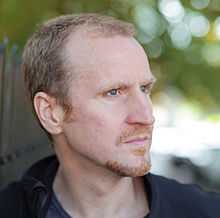Philip Clemo
| Philip Clemo | |
|---|---|
 Philip Clemo, Glasgow 2012 by Colin Gray | |
| Background information | |
| Birth name | Philip James Clemo |
| Born |
3 August 1964[1][2] Insch, Aberdeenshire, Scotland |
| Genres | Classical, jazz, atmospheric, ambient, electronic, experimental rock |
| Occupation(s) | Composer, film maker, artist |
| Instruments | Voice, guitar, piano, keyboards |
| Years active |
Music: 1997–present Film: 1989–present |
| Labels | All Colours Arts, Metier[3] |
| Associated acts | Ysanne Spevack |
| Website |
www |
Philip Clemo is a British composer, musician, record producer, sound artist, filmmaker and visual artist,[1][4][5][6] described as one of contemporary music's most innovative artists.[7]
Early life
Philip James Clemo was born on 3 August 1964 in Insch, Aberdeenshire, Scotland, the youngest child of the head of the local veterinary practice. His paternal grandfather was George Roger Clemo, Professor of Organic Chemistry at Newcastle University. Clemo attended Insch Primary School and Inverurie Academy, and later went on to study Electronics and Communications Engineering at the Universities of North London and North East London.[1]
As a child he built his own music and lighting system and began running music nights for school friends at his home.[4][5] As well as contemporary acts he was influenced by the musical collection of his six-year older brother, particularity the later works of The Beatles, including Sgt. Pepper's Lonely Hearts Club Band and the Blue Album.[4][5] As a teenager he began taking acoustic guitar lessons from local singer-songwriter Iain MacDonald, who had brought out a couple of albums in the 1980s and has recently returned to recording and performing. MacDonald brought folk music influences into his life, and the works of Nick Drake, Tim Buckley, Van Morrison, Neil Young and Bob Dylan, through which he began playing in local folk clubs.[4][5]
Developed style
Moving to London in 1982, influenced by the works of Robin Guthrie of The Cocteau Twins and Tom Verlaine of Television, Clemo moved into multitrack recording.[4][5] Now living in Hackney, East London, he put together a short-lived experimental music band Box in the Sun, but left to explore his musical freedom.[4][5] Inspired mainly by the works of David Sylvian of Japan, the Cocteau Twins, late-period Talk Talk, Television and Brian Eno, he was also influenced by diverse engagement across artists from Debussy, Arvo Pärt, David Toop, Gavin Bryars, Holger Czukay and Steve Reich to Patti Smith.[4][5]
This journey fired Clemo's interest into how music was created, which inspired his own non-traditional approach to piece development, through a multi-layered technique which results in a greatly textural output.[4][5] With the aim of creating inspiring music which always sounds fresh to the listener, Clemo builds soundworlds from diverse sources including field recordings made in locations such as: the crowded streets of New Delhi; the dense insect soundscapes of the Malaysian rainforest; Sydney building sites; Icelandic mud pools; and glass and metal workshops.[4][5] In the studio he builds complex and densely textured compositions, developing them through a process of composition and improvisation, with contributions from a diverse group of musicians. During the final stages he extensively reconfigures, interweaving instrumental, vocal and recorded material, disguising origin and cultural references.[8][9][10] The result is a mix of musical genre, which crosses between jazz, rock, contemporary classical and electronica,[3][11] described as "finely crafted shimmering matrices of sound"[8] and creating something which is "mesmeric and completely addictive".[2][9]
Musical career
Sound – Inhale the Colours
Clemo's first two albums were collaborative works with violinist Ysanne Spevack, aka Mee.[2] The pair shared the composition credits, but used Clemo's multi-layered approach to creation and composition. Sound – Inhale the Colours was created in 1996/7 largely in Sydney, featuring contributions from an additional eleven musicians. Well reviewed by critics on release, it remained a question for them as to whether it was jazz, ambient electronica or World music.[12][13]
Soundzero
A second collaborative album Soundzero was completed in 1999, but only released in March 2008.[14] Both albums featured, amongst others, Phil Slater on trumpet and Tarlochan (Bobby) Singh on tabla. On Soundzero, Jazz singer Cleveland Watkiss, often heavily processed, made a guest appearance; whilst the album was also the first appearance of a British rhythm section, consisting of: Mark Sanders (drums); John Edwards (double bass); and Pete Lockett (percussion).[4][5]
Ambiguous Dialogues
Clemo's third album Ambiguous Dialogues, the first under his own name, was released in 2004 on Metier Jazz.[2][3] Featuring 12 musicians, as well as the British rhythm section it involved contributions from Clive Bell (reeds), and Tom Chant (soprano saxophone and bass clarinet). Clemo toured the work post the album's release, which was well reviewed and received.[11][15]
During the same year, he became a judge for the first time at the British Composer Awards for the British Academy of Songwriters, Composers and Authors, which he has since undertaken again in 2005, 2006, 2010 and 2011.[1][2][4][5][3]
The Rooms
In October 2008, Clemo released his fourth album The Rooms. A musical progression through different sound "rooms" or "spaces", it featured 22 musicians including: Clive Bell; Theo Travis (saxophone and flute); Simon Hopkins (electric guitar); B.J Cole (pedal steel); Henry Lowther (trumpet and flugelhorn); and a Prague string quartet. Clemo credited legendary sound engineer Phill Brown, who has worked with Jimi Hendrix and Bob Marley among others, for his invaluable contribution to the recording process of The Rooms. The album was critically acclaimed, and reviewed as floating somewhere between jazz, rock and soundtrack,[16] with critics describing it as intelligent "fourth world" electro-jazz.[8][9][10][11]
Mesmer
Up to this point, one of Clemo's key instruments of choice to compose with was the guitar. But having become quite bored with what he was playing on it,[4][5] he moved for his next album to the piano. For a year he created improvisations, charting a deeply personal journey through significant life experiences and environments.[4][5] These were then given to pianist Kevin Pollard to interpret and expand, with Clemo then adding additional guitar pieces to shape the compositions.[4][5] With the basic structure laid out, he then invited 14 additional musicians – one at a time – to "blindly" add their response on top, including: Oren Marshall (tuba); B. J. Cole (pedal steel guitar); Byron Wallen (trumpet and flugelhorn); Emily Burridge (cello); with Thomas Bloch (Radiohead, Damon Albarn) contributing ethereal tones on three instruments (glass harmonica, crystal baschet and ondes martenot). Clemo then heavily edited and shaped their contributions. The album was the first on which Clemo added his own voice, using multi-layering to create harmonies.[7] He finally added additional recorded sounds from places which have great significance to him, including: the river and woods at the end of his childhood garden; his first school; Aberdeen railway station; Redwood National Park in northern California; and Plum Village Zen Buddhist monastery in France.[3][4][5] As with The Rooms, most of the sessions were recorded by Phill Brown, who Clemo sees as crucial in both building powerful creative environments, and capturing a high level of sonic detail in the sessions.[7] The end result, Mesmer,[3] was well reviewed by both the music[17][18][19] and mainstream press,[20][21][22] described as a form of contemporary chamber music with "improvisation, multi-level musical dialogue and sound design at its core."[7]
Film-making

Having started out professionally as a production film editor, including working on the BBC's Panorama,[23] since summer 1989 Clemo has made a series of short films which have been shown at festivals around the world.[6]
One of his early films was From The Morning On, a travelogue based on a day in the Indian sub-continent.[6] He has since travelled extensively throughout South East Asia and Australasia, with both film camera and sound recording equipment.[6] Having used video projections of his film work extensively in his live musical performances, he filmed his first major project, The Air Holds Still on My Breath in Iceland in summer 2008. Shown at Cannes Short Film Corner in 2009,[6] the film, a series of abstract "mood paintings" mapping the "Seven Ages of Man", features music from The Rooms.[6] It was shot using specialist camera technology to capture extreme slow motion details of geothermal activity and waterfalls, and from the air using a gyro-stabilised camera mounted on a helicopter.[23] Shot using the same technical combination as The Air, Clemo made the short film Melt, which was shown at 2009 Reykjavik International Film Festival 2009 and 2010 London Short Film Festival.[6]
Since late 2013, Clemo has been working on The Breath Project, encompassing a feature film and art installation produced by perfectmotion and Animal Monday. Breath illustrates the dramas of human life through the metaphor of landscape, from isolation and turmoil to exhilaration and transformation. Moving through the seven phases of human life, through ageing human forms and across different terrains of the human body, we see comparisons with the environments of planet Earth.[1]
Discography
- Sound – Inhale the Colours, 1997, with Mee (Ysanne Spevack)
- soundzero, 1999 (but only released in 2008), with Ysanne Spevack
- Ambiguous Dialogues, 2004
- The Rooms, 2008
- Mesmer, 2012
Filmography
- Box in the Sun, 1990
- From the Morning On, 1990
- Objects and Observations, 1993
- Thieves – Unworthy promo, 1994
- An Altered Perspective (Journeys in the East), 1995
- Metal on Water, 1999
- Separated by Shadows (shown during 2005/6 UK tour), 2005
- The Air Holds Still on My Breath (Iceland Journey), 2009
- Melt, 2009
- Sigur Rós – Fjögur Píanó, 2012
- The Mesmer vignettes, 2012
- Return, 2013
- Wide-eyed, 2013
- Orchid, 2013
- The Memory of Objects: Château de Rochebonne, France, 2014
- Breath (Journeys Through the Landscapes of Life) (in development), 2015
References
- ↑ 1.0 1.1 1.2 1.3 1.4 "Official Website". Philip Clemo. Retrieved 30 April 2014.
- ↑ 2.0 2.1 2.2 2.3 2.4 "Philip Clemo". BBC Music. Retrieved 30 April 2014.
- ↑ 3.0 3.1 3.2 3.3 3.4 3.5 "Philip Clemo". Manners McDade. Retrieved 30 April 2014.
- ↑ 4.0 4.1 4.2 4.3 4.4 4.5 4.6 4.7 4.8 4.9 4.10 4.11 4.12 4.13 4.14 Paul Tingen (2011). "Philip Clemo". Paul Tingen. Retrieved 30 April 2014.
- ↑ 5.0 5.1 5.2 5.3 5.4 5.5 5.6 5.7 5.8 5.9 5.10 5.11 5.12 5.13 5.14 Royle, Nicholas (2009). "A profile of Philip Clemo". The Guardian (The Guardian & Nicholas Royle).
- ↑ 6.0 6.1 6.2 6.3 6.4 6.5 6.6 "Philip Clemo". Reverb Nation. Retrieved 30 April 2014.
- ↑ 7.0 7.1 7.2 7.3 "Philip Clemo – Mesmer". propermusic.com. October 2012. Retrieved 30 April 2014.
- ↑ 8.0 8.1 8.2 "Philip Clemo – The Rooms". Jazzwise. October 2008.
- ↑ 9.0 9.1 9.2 "Philip Clemo – The Rooms". The Wire. October 2008.
- ↑ 10.0 10.1 Chris Fortescue (October 2008). "Philip Clemo". All About Jazz]]. Retrieved 30 April 2014.
- ↑ 11.0 11.1 11.2 John L Walters (17 October 2008). "Jazz review: Philip Clemo: The Rooms". The Guardian. Retrieved 30 April 2014.
- ↑ Tony Marcus (1997). "Sound – Inhale the Colours". Mix Mag.
- ↑ Andrew Rawnsley (1997). "Sound – Inhale the Colours". XLR8R.
- ↑ As stated in the Chain DLK review
- ↑ John Fordham (28 March 2006). "Philip Clemo – 93 Feet East, London". The Guardian. Retrieved 30 April 2014.
- ↑ Chris Jones (October 2008). "Philip Clemo – The Rooms". BBC Music. Retrieved 30 April 2014.
- ↑ "Philip Clemo – Mesmer". All Music Guide.
- ↑ "Philip Clemo – Mesmer". The Wire (magazine). October 2012.
- ↑ "Philip Clemo – Mesmer". Mojo (magazine).
- ↑ "Philip Clemo – Mesmer". The Observer. October 2012.
- ↑ "Philip Clemo – Mesmer". The Times.
- ↑ "Philip Clemo – Mesmer". Financial Times. Retrieved 30 April 2014.
- ↑ 23.0 23.1 Kieron Seth. "ALEXA, Alura and aurora borealis". Arri. Retrieved 30 April 2014.